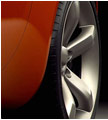|
Tk3D Software: Description
What is Tk3D?
Tk3D is a collection of extensions to Tcl/Tk that allow Tcl/Tk applications to
manipulate large numerical arrays and generate 3D graphic
displays.
What packages does it contain?
The Tk3D suite contains five packages, named
Tns, Vtd, Fct, Fctr, and Tnsph. The "Tns" (tensor) package
is a numerical array extension. It provides facilities for
efficiently manipulating multidimensional arrays of numbers
within Tcl. The Vtd package provides a Tk widget, called a
view3d widget, in which to display 3D graphic images. This
widget's functionality can be extended by adding "renderers,"
which are programs, written in C, for drawing objects in a
view3d widget.
In addition, the Tk3D graphics suite contains
several support packages and extensions that are useful in
their own right. The Fct (faceted object) package implements
a kind of faceted surface model. Faceted objects contain a
list of three-dimensional vertices and lists of lines, triangles,
and quads. The line/triangle/quad lists indicate how the vertices
are connected together to form surfaces. Although the intended
purpose of the Fct package is to provide display lists for
the view3d widget, it was written as display-independent code;
it can, in fact, be run from tclsh without Tk, so that displays
can be built and manipulated offline. Display of faceted objects
is performed by the Fctr (faceted object rendering) package,
which extends the view3d widget with a faceted object renderer.
Finally, the Tnsph (tensor-to-photo) package facilitates transfer
of data between tensors (as provided by the Tns package) and
Tk's photo image objects. This allows the user to transfer
a native Tk image into a tensor, perform image processing
operations, and then convert the processed image back into
a Tk image.
Where do I get the code?
The extensions that constitute the Tk3D
suite are available in source form and have been run on Windows
and on several flavors of Unix. Before downloading, you must
first read and agree to the License Agreement; you can then access the
code.
|




